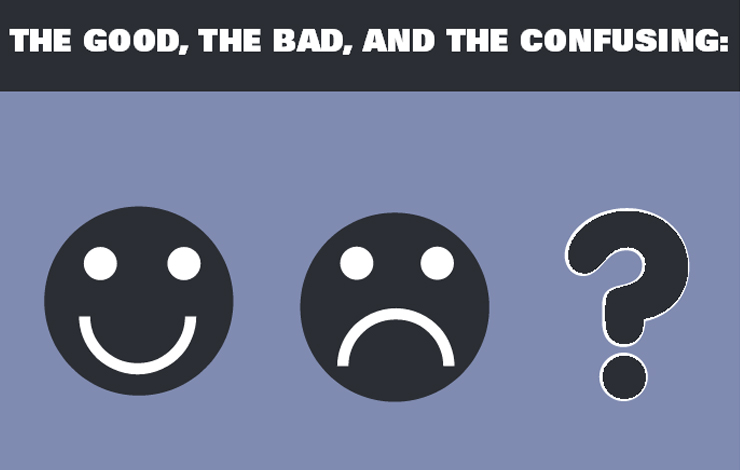
"The Good, The Bad and The Confusing," a report by Pat Aufderheide and Peter Jaszi of the Center for Social Media
Is the climate of copyright fear and the clearance culture that documentary filmmakers know too well going to be brought to the Web environment? A study conducted jointly at American University's Center for Social Media and Washington College of Law
suggests that, far from motion picture industry claims, many budding online video creators are even more afraid of copyright violations than they may need to be. They are not aware of their basic rights to quote copyrighted material without permission or payment, and they do not have any idea of how to obtain licenses to copyrighted material they should license.
In the chaotic environment of today's Internet, fear and anxiety over copyright is far more prevalent than widely thought. Fear and anxiety act as powerful disincentives to creativity--exactly what new technological access and tools are supposed to unleash.
"The Good, the Bad and the Confusing: User-Generated Video Creators on Copyright" is a study that was conducted in spring 2007 with college students and college-age makers of Internet video. These are, by and large, people who expect to earn a professional living in tomorrow's communications environment. The survey pool was anonymous and small (51 respondents), although widely and intensively circulated over five weeks. Interviews were also conducted with 15 makers, each of whom was known at least through the second degree to the interviewer. Researchers thus discovered substantial resistance to answering questions about copyright, both in the anonymous survey and in interviews-evidence, they believe, of widespread anxiety about whether users are violating the law.
Some of the report's discoveries include:
- Most of the creators quote from a wide variety of copyrighted sources; although they rarely do get licenses for this work, most of them think they should, even when fair use would cover their uses--according to the Documentary Filmmakers' Statement of Best Practices in Fair Use.
- The creators explain their copyright use with a range of justifications that would not hold up in law ("I'm not making any money off it"; "I don't think [the copyright holder] will see it"). Meanwhile, not a single maker could define fair use, thus depriving them of a justification that would.
- Creators who have received film training have often mis-learned copyright law, including the belief that "everything must be cleared." In these cases, this mis-education discouraged people from posting or otherwise sharing their work.
- Creators universally valued their own copyright but didn't know how work is copyrighted (it is copyrighted by default), often believed it would be expensive to get, and often did not believe they held copyright in their created work.
- Creators sometimes decided not to make or share work because of their concern over copyright. They also attempted to limit circulation of their work because of this concern.
This confusion is occurring at a wildly creative and exciting--if uncertain and messy--moment on the Web. Many online video creators are repurposing existing content to make funny, critical or just plain goofy comments. (See the Center for Social Media's four-minute video, Remix Culture], for a "greatest hits" overview of unauthorized uses of copyrighted material.) Everyone knows this heady, experimental moment won't last. It will change as business models evolve and as rules of the road are created.
"The Good, the Bad and the Confusing" shows that well-intentioned, well-educated online video creators feel the lack of rules of the road for this new environment--and indeed, may be dangerously cautious about the old environment as well. Large media companies worry that habits of lavish copying of copyrighted materials may fatally compromise their existing business models. The Center for Social Media research suggests another danger--that people who have grown up with a constant litany of anti-piracy messages may confuse legitimate and legal quotation of copyrighted works with piracy, and weaken the next generation's creative documentary work.
Some corporations, as well as many nonprofits, are similarly concerned; there are many corporations whose business models depend upon the creative, if unpredictable, growth of user-generated content. "Unauthorized," a recent convening produced and presented by the Center, brought together online video businesses with nonprofits to assess their copyright concerns--especially in the wake of Viacom's lawsuit against Google for copyright infringement at YouTube. A summary of that meeting, "Unauthorized: The Copyright Conundrum in Participatory Video."
The work that documentary filmmakers did in creating their Statement of Best Practices provides an excellent and sturdy model for addressing copyright practice going forward into the Internet video era. Documentary filmmakers used the power of their own professional status to educate their peers, colleagues and business partners. It worked extraordinarily well--public broadcasters, cablecasters and networks are now recognizing fair use claims again, and the majority of errors-and-omissions insurers also honor fair use claims, all because the Statement exists.
Those who make and showcase Internet video need to act as self-educators and educators of peers, to lower anxiety and fear and increase the capacity of new creators to use the law responsibly. When that happens, new creators as well as existing copyright holders are all protected both for their rights as owners and as users.
Pat Aufderheide is director of the Center for Social Media at American University.
